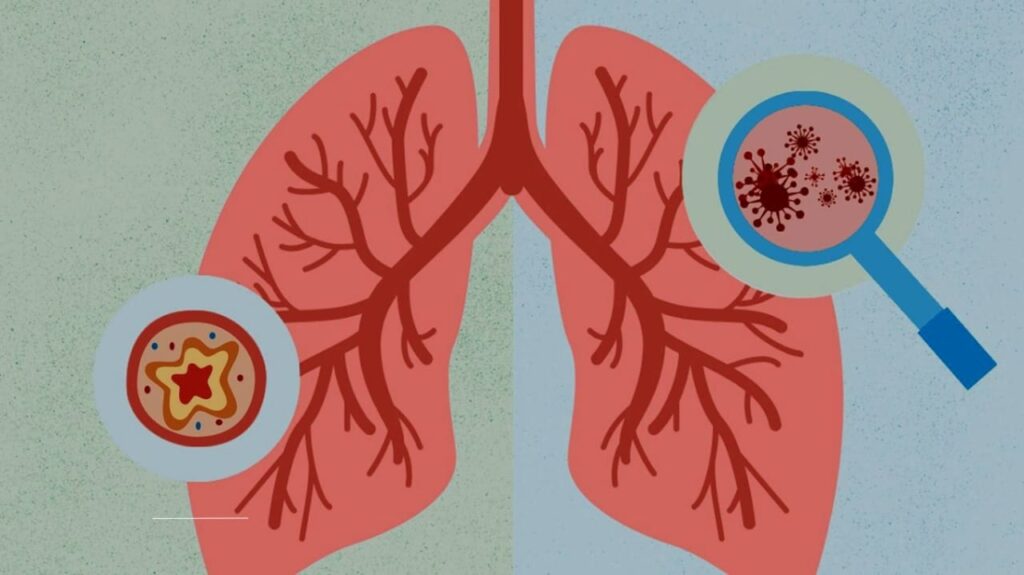
When it comes to respiratory infections, pneumonia and bronchitis are two conditions that often get confused. Both affect the lungs, cause coughing, and can make you feel downright miserable. But despite their similarities, they are distinct illnesses with different causes, symptoms, and treatments. Understanding the differences between pneumonia and bronchitis can help you seek the right care and recover faster.
In this article, we’ll break down everything you need to know about pneumonia and bronchitis, from their causes and symptoms to how they’re diagnosed and treated. By the end, you’ll have a clear understanding of these two common yet often misunderstood conditions.
What Is Bronchitis?
Bronchitis is an inflammation of the bronchial tubes, which are the airways that carry air to your lungs. When these tubes become irritated or infected, they swell and produce excess mucus, leading to coughing and difficulty breathing.
Types of Bronchitis
There are two main types of bronchitis:
- Acute Bronchitis: This is the more common form and is usually caused by a viral infection, such as the flu or a cold. It typically lasts for a few weeks and resolves on its own.
- Chronic Bronchitis: This is a more serious condition and is often linked to long-term exposure to irritants like cigarette smoke or air pollution. It’s a type of chronic obstructive pulmonary disease (COPD) and requires ongoing management.
Symptoms of Bronchitis
The hallmark symptom of bronchitis is a persistent cough that may produce mucus. Other symptoms include:
- Fatigue
- Shortness of breath
- Mild fever and chills
- Chest discomfort
- Sore throat
Bronchitis is often mistaken for a cold or flu because the symptoms overlap. However, the cough in bronchitis tends to last longer, sometimes for several weeks.
What Is Pneumonia?
Pneumonia is an infection that inflames the air sacs in one or both lungs. These air sacs, called alveoli, can fill with fluid or pus, making it difficult to breathe. Pneumonia can range from mild to life-threatening, depending on the cause and the patient’s overall health.
Causes of Pneumonia
Pneumonia can be caused by:
- Bacteria: The most common cause of bacterial pneumonia is Streptococcus pneumoniae.
- Viruses: Respiratory viruses, including the flu and COVID-19, can lead to viral pneumonia.
- Fungi: This is less common and usually affects people with weakened immune systems.
- Aspiration: Inhaling food, liquids, or vomit into the lungs can cause aspiration pneumonia.
Symptoms of Pneumonia
Pneumonia symptoms can vary widely depending on the cause and severity of the infection. Common symptoms include:
- High fever
- Chills and sweating
- Cough with phlegm (which may be green, yellow, or bloody)
- Shortness of breath
- Chest pain, especially when breathing or coughing
- Fatigue and confusion (especially in older adults)
Unlike bronchitis, pneumonia often causes more severe symptoms and can lead to complications if not treated promptly.
Key Differences Between Pneumonia and Bronchitis
While both conditions affect the respiratory system, there are several key differences between pneumonia and bronchitis:
1. Affected Area
- Bronchitis: Affects the bronchial tubes (airways).
- Pneumonia: Affects the alveoli (air sacs) in the lungs.
2. Causes
- Bronchitis: Usually caused by viruses, though chronic bronchitis is often linked to smoking or environmental irritants.
- Pneumonia: Can be caused by bacteria, viruses, fungi, or aspiration.
3. Symptoms
- Bronchitis: Primarily a persistent cough, often with mucus. Fever and fatigue are usually mild.
- Pneumonia: More severe symptoms, including high fever, chills, chest pain, and difficulty breathing.
4. Duration
- Bronchitis: Acute bronchitis typically lasts 1-3 weeks. Chronic bronchitis persists for months or years.
- Pneumonia: Symptoms can improve within a week with treatment, but recovery may take longer, especially in older adults or those with underlying health conditions.
5. Severity
- Bronchitis: Generally less severe, though chronic bronchitis can significantly impact quality of life.
- Pneumonia: Can be life-threatening, especially in vulnerable populations like infants, older adults, and people with weakened immune systems.
Diagnosis: How Are Pneumonia and Bronchitis Identified?
Diagnosing pneumonia and bronchitis involves a combination of medical history, physical exams, and diagnostic tests.
Diagnosing Bronchitis
- Medical History: Your doctor will ask about your symptoms, how long you’ve had them, and whether you’ve been exposed to irritants like smoke.
- Physical Exam: They’ll listen to your lungs with a stethoscope to check for abnormal sounds like wheezing.
- Tests: In most cases, no tests are needed for acute bronchitis. However, if chronic bronchitis is suspected, a chest X-ray or pulmonary function test may be ordered.
Diagnosing Pneumonia
- Medical History: Your doctor will ask about your symptoms, recent illnesses, and any risk factors (e.g., smoking, travel, or exposure to sick individuals).
- Physical Exam: They’ll listen for crackling or bubbling sounds in your lungs, which can indicate pneumonia.
- Tests: Common diagnostic tests include chest X-rays, blood tests, and sputum tests to identify the cause of the infection.
Treatment Options for Bronchitis and Pneumonia
The treatment for bronchitis and pneumonia depends on the cause and severity of the condition.
Treating Bronchitis
- Acute Bronchitis: Since it’s usually caused by a virus, antibiotics are not effective. Treatment focuses on relieving symptoms with rest, hydration, and over-the-counter medications like cough suppressants and pain relievers.
- Chronic Bronchitis: Management includes quitting smoking, avoiding irritants, and using medications like bronchodilators or steroids to open the airways.
Treating Pneumonia
- Bacterial Pneumonia: Treated with antibiotics. It’s important to complete the full course of medication, even if you start feeling better.
- Viral Pneumonia: Antiviral medications may be prescribed, but most cases require supportive care like rest, fluids, and fever reducers.
- Severe Pneumonia: Hospitalization may be necessary, especially if you have difficulty breathing or other complications.
Prevention Tips
Both pneumonia and bronchitis can often be prevented with a few simple steps:
- Get Vaccinated: Vaccines for the flu and pneumococcal pneumonia can reduce your risk.
- Practice Good Hygiene: Wash your hands regularly and avoid close contact with sick individuals.
- Quit Smoking: Smoking is a major risk factor for both chronic bronchitis and pneumonia.
- Boost Your Immune System: Eat a healthy diet, exercise regularly, and get enough sleep to keep your immune system strong.
FAQs
1. Can bronchitis turn into pneumonia?
Yes, in some cases, untreated bronchitis can lead to pneumonia, especially if the infection spreads to the lungs.
2. How can I tell if I have bronchitis or pneumonia?
While both cause coughing, pneumonia typically involves more severe symptoms like high fever, chills, and chest pain. A doctor can confirm the diagnosis with a physical exam and tests.
3. Are antibiotics effective for bronchitis?
Antibiotics are only effective for bacterial infections. Since most cases of acute bronchitis are viral, antibiotics are not usually prescribed.
4. Who is at higher risk for pneumonia?
Older adults, young children, and people with weakened immune systems or chronic health conditions are at higher risk for pneumonia.
5. Can I prevent bronchitis and pneumonia?
Yes, practicing good hygiene, getting vaccinated, and avoiding smoking can significantly reduce your risk of both conditions.
